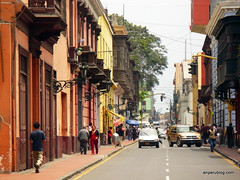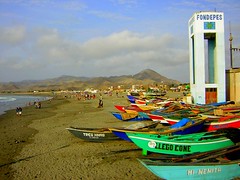From Lima to the Rock Gardens of Marcahausi
Article and Photos by Kaitlin Nunn, at Peru For Less, specialists in Peru travel packages.
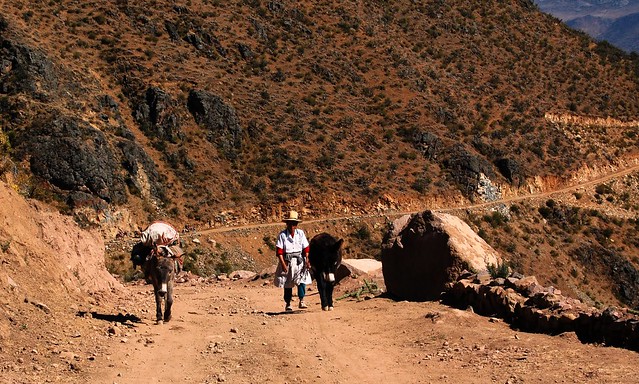
I was not expecting to careen along a dirt road so narrow that our bus often had to stop to let a goatherd and his goats pass. I was not expecting to be passed up along the hiking trail by campesinos more than three times my age, most of them carrying loads of firewood or harvested crops. And I certainly wasn’t expecting to be chased down the trail by a donkey.
Few visitors to Peru make it to the little farming village of San Pedro de Casta and its nearby volcanic plateau Marcahausi. Perched 11,000 feet high between the Santa Eulalia and Rimac valleys, the pueblo seems to have escaped modernity. Burros, horses, and dogs scattered all around the town square. Atop tin roofs chopped cow legs are left to bake in the sun.
But San Pedro de Casta is slowly becoming a magnet for backpackers, campers, and mountain bikers seeking to escape the garúa, or coastal fog, that plagues Lima during the winter months, and who want to explore the fascinating landscapes at the top of the mountain, about a 2 mile hike from San Pedro.
I didn’t do much planning before setting out. I just paid for a round-trip ticket from Lima to San Pedro, bought enough food to keep me going, packed my camping gear and caught the bus into the mountains.
I went with a group of mountain bikers. We threw our packs and bikes onto the bus and hopped in for the three hour drive to Marcahausi.
About an hour out of Lima, we reached Chosica, the sunny town just east and inland. Limeños come here during winter weekends to get their vitamin D. I bought a large glass of fresh squeezed orange juice – and downed it in almost one gulp – instant refreshment for .35 cents
We continued eastward 90km, winding through the Santa Eulalia river valley dotted with haciendas, each draped in red, yellow, and purple bougainvillea. The road began to climb into the hills, careening around sharp switchbacks along a narrow, dirt road until we reached San Pedro, where local families farm the nearby terraced fields, raise donkeys and travel on horse drawn carts.
While still rooted to the land, San Pedrans seem to be embracing tourism whole-heartedly, and are no strangers to visitors on weekend getaways from the capital.
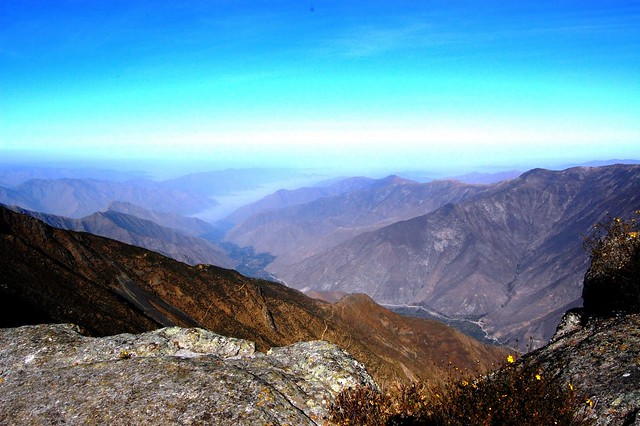
Above the town winds a steep dirt bridle trail up to the rock plateau known as Marcahausi. The trail is around 2 miles, with an elevation gain of about 2,000 feet. The trail is difficult, as the air is thin, the climate is hot, and trekkers have to lug their camping gear, water, and firewood.
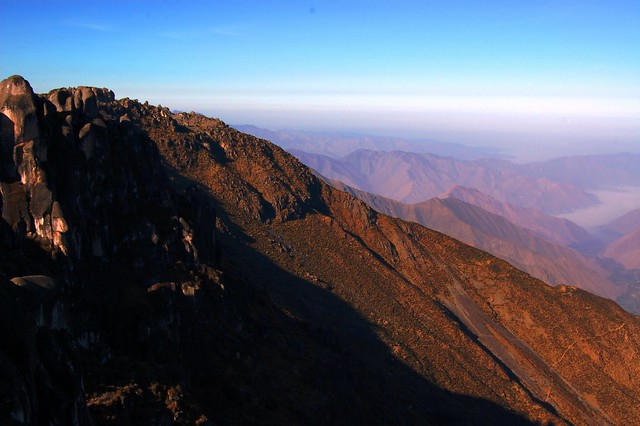
Usually, visitors hire a donkey in town to carry their packs up the trail. Or, they’ll hire a horse to ride. There were no donkeys available, so we decided to start the trek and hire donkeys along the way.
The afternoon was hot and the air was dusty. The trail was lined by a dense wall of cacti, above which vistas of the valley and mountains continued into infinity. The trail turned from burnt sienna to deep red. I passed a Eucalyptus grove and rested in its shade. At one point I was nearly run off the trail by a herd of goats.
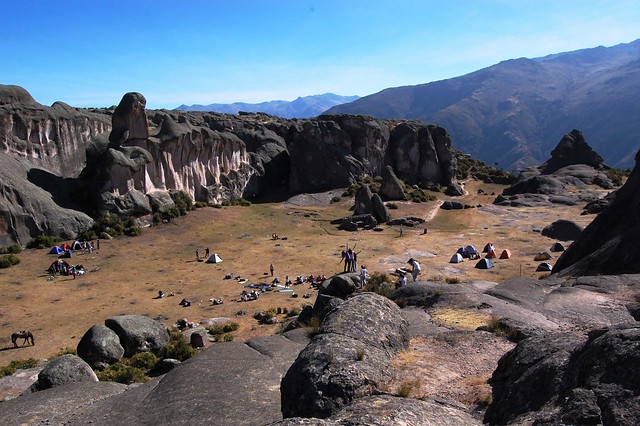
The trail forks about halfway. We took the Camino Largo, which is longer but more gradual, than the Camino Corto. When you reach the cabañita and the archway at the top, I stepped into the spectacular Marcahausi ‘amphitheatre’, the popular camping spot surrounded by jaw-like volcanic rocks.
We started the campfire and the rest of our group soon caught up. We watched the full moon rise over the gorgeous, smooth volcanic rocks. The fire, along with some strong pisco and whiskey, kept us warm for a few hours.
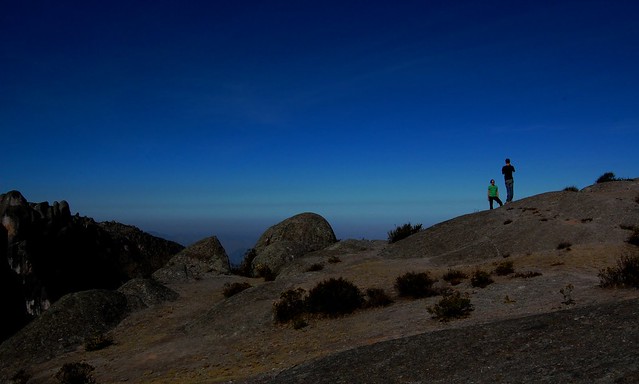
The night time temperature was probably about zero degrees Celsius and in the morning, the warming sunrise was more than welcome. I unzipped the tent door singing Halleleuja.
We spent the morning exploring the other-worldly natural rock sculptures of the Marcahausi plateau. We climbed out of the amphitheatre onto the valley to the edge of the canyon.
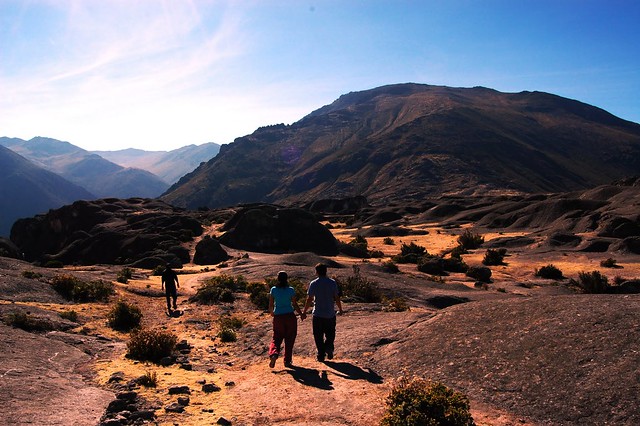
The plateau we were standing on seemed to be an endless table of rounded rock, made of granite and diorite. It looked like a dry riverbed, smoothed by water a long time ago. Most likely, the rocks were smoothed by lava, or perhaps rain or wind.
If you buy a map in San Pedro, you can traipse along the plateau to find the highlights yourself, or you can hire a guide. They all have slightly sci-fi names, like the Druid and the Goddess Thueris. The most popular rock feature is the Monument to Humanity, also known as Gasha Peca, a Quechua word meaning witch.

The trail back to town took about an hour and a half. Along the way, we stopped the locals carrying transistor radios to ask them the World Cup score. A campesina and Valentina, her grinning nine year old daughter, stopped and sat next to me as I rested. She explained that she was heading to her cows to feed and milk them, and bring the milk back to town where the cheese would be processed.
Back in town, we grabbed a beer at La Cabañita, right off the trailhead. Then we sought out a quieter place for lunch, a small restaurant just steps off the main square that serves a decent two-course menu. Spanish music and a TV play in this lunch spot that acts as the school cafeteria during the week. The pasta soup and pollo frito are delicious. There are also decent bathrooms and a sink in the adjacent school courtyard.
I peeked inside the tiny museum next door. This one room museum is no Smithsonian, but it does have good color photographs of the various geoglyphs, a few informational paragraphs (in English and Spanish) on the history of the people, and several encased mummies.
Later we walked to the mirador, a lookout point where you can see the whole town and the Santa Eulalia Valley below, as well as that narrow, winding dirt track that would take us back to the bustle of Lima.
How do I get there?
Lima to Chosica – public bus or combi (1 hour) $1.50, taxi $8
Chosica to San Pedro de Casta – (2-3 hours) public bus $3.50
San Pedro de Casta to Marcahuasi – (3-4 hours) walking $1.75
How can I do the hike?
Entry to Marcahuasi – Students $1, Adults $1.75, Foreigners: $3.50 (pay in the tourist office off the main square before hiking)
Rent donkey to the amphitheatre – $4.50
Rent horse to the amphitheatre – $5.50
Bundle of firewood – $1.75
Note: if you arrive late in the day or at night, it’s best to camp near San Pedro de Casta or stay in one of the two cheap hotels in town (about $3.50).
When to go?
The dry season, from May to November, is best. Daytime climate is temperate. Nights get down to about zero degrees Celsius. You may want to plan your trip around San Pedro de Casta holidays, like Easter week, Fiestas Patrias, the fiesta in June, and the water festival in October.
Where to camp?
The most popular camping spot is the amphitheatre, but there are other spots to camp near the fortress.
If you want to escape the crowd – the amphitheatre sees about 30 tents on an average night – trek just a little further beyond the far wall, and you’ll find a patch perfect for a couple tents. Plus, you have a front row view of the spectacular canyon.
The leading Peru Travel Agency with more than 2,500 satisfied international travelers a year from over 30 countries. Find out why.
Tags: marcahuasi, monolith, san pedro de casta, santa eulalia




![A Peruvian’s view on the problem of corruption [Featured]](http://farm4.static.flickr.com/3142/2893338595_55ba4bdb3e_m.jpg)
![Visit to Chakiccocha [Featured]](http://farm2.static.flickr.com/1343/555374565_37d7873380_m.jpg)
